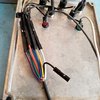My Arduino project has 7 buttons and 2 LEDs mounted on the lid of my 3 1/4" by 4 1/2" aluminum box. I'd like to minimize the number of connections to the box mounted circuit board. Each of these components requires its own 5v connection, but I would like to wire all 7 grounds to a single wire leading to a header on the circuit board. One way I've been playing with is connecting all the component grounds to a single bare wire that follows a serpentine path and terminates with a male connector to a circuit board female header.This worked, but soldering was tedious and I managed to damage 2 on the buttons in the process. Worse, replacing 1 bad button requires starting all over again!
Plan B is to use buttons with pre-soldered leads and connect all the black leads to some kind of a "hanging header" with 8 positions: 7 for the incoming grounds and 1 to be connected to the circuit board. I tried searching at Mouser, but wasn't able to find anything like this probably because I don't know what would be called. Is there such a thing?
Or, what is Plan C?
Any suggestions welcome.
Plan B is to use buttons with pre-soldered leads and connect all the black leads to some kind of a "hanging header" with 8 positions: 7 for the incoming grounds and 1 to be connected to the circuit board. I tried searching at Mouser, but wasn't able to find anything like this probably because I don't know what would be called. Is there such a thing?
Or, what is Plan C?
Any suggestions welcome.



